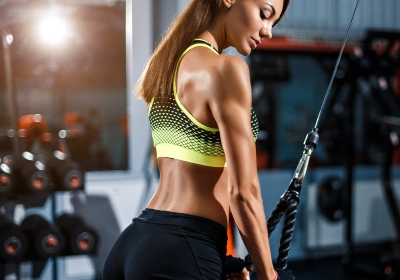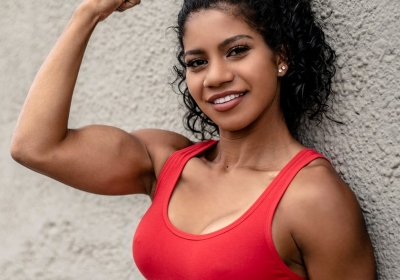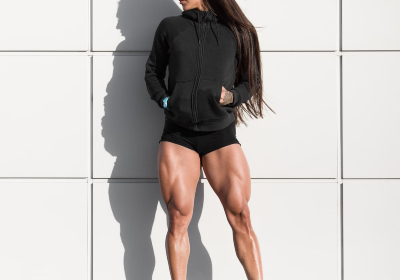VIDEO
Burpees
- Arms
- Shoulders
- Quads
- Hamstrings
- Chest
Level:Intermediate
Trainer:Nick Taylor
Equipment:No Equipment
Burpees
- Arms
- Shoulders
- Quads
- Hamstrings
- Chest
Level:Intermediate
Trainer:Nick Taylor
Equipment:No Equipment
Start standing with your feet hip distance appart. Bend down and place your palms on the floor in the front of your feet. As soon as your palms make contact with the floor, jump your feet out behind you to assume a high-plank position. Keep your core tight and your spine straight. Stand up and jump reaching your arms above the head.
save to ...
RECOMMENDED FOR YOU
ARTICLES
This time we suggest paying special attention to the chest muscles. It is this zone that many athletes want to pump, but it is not so easy to do and one classic chest press is not enough.
Chest muscles are one of the most complex and largest muscle groups.
Therefore, competent training must be a combination of basic and isolation exercises. Only in this way, it will be possible to load the muscles at different angles. Exercises with barbells are suitable for increasing muscle mass, and with dumbbells, on blocks and training machines - for improving the form and detailed elaboration. These exercises also activate the stabilizing muscles.
Imagine that the chest muscle is a rubber band that connects the shoulder, collarbone, and sternum. If you lift your arm to the side and then pull the elastic band, it will move your shoulder forward. You do this movement all the time in your normal life like when you close a door, push something away with force, or elbow your jaw.
Most pectoral muscle exercises repeat this movement. The only difference is that they also use a barbell, dumbbells, or crossover slings to create extra resistance.
The chest muscle has two heads: an upper head (clavicle) and a lower head. Their functions are slightly different, and this is important. In order to have a symmetrical chest, you need to pump both heads.
The fibers of the clavicular head are directed upward, so you need to move the shoulder forward from the bottom to the top for additional exercise.
Many people believe that the more they pump their chest, the faster their muscle mass will increase. In fact, this has a negative effect on muscle growth. The muscle gets bigger during rest when the tissues are recovering from an active workout. There are a few tips on how to properly pump your pecs and not overtrain:
Exercise no more than 2 times in 7 days. In between do physical exercises on other parts of the body;
Do not exercise for more than 45 minutes, as this may cause muscle size and strong growth to regress.
Exercises that help you to pump the chest muscles include:
push-ups.
bench presses.
triceps push-ups.
To pump your muscles evenly, alternate your exercises. The bench press is great, but you don't have to do it in every workout, because there are other good options.
Choose the weight so that the last reps in an attempt are difficult. If you find it easy and your muscles don't tire, they won't grow.
Avoid flying in the clouds during the workout: concentrate on the muscle work. It really helps you to pump it better.
Perform 3-5 sets of 8-12 reps. Do not use weights that are too heavy. Especially at the beginning if you do not have a good command of technique.
Read more
The muscle on the back of your shoulder is called the triceps. Triceps originate from the scapula and humerus and attach to the ulna using the triceps tendon. The triceps muscle does the function of extension in the elbow and acts as an auxiliary in the implementation of other movements in the shoulder. During triceps contraction, the vector of movement is transmitted using the tendon.
The mass fraction of the triceps is approximately 2/3 of the muscles of the shoulder, so its size plays a critical role in the formation of beautiful arms. By focusing on the biceps, and forgetting about the triceps muscle, athletes contribute to getting inharmoniously developed arms.
You shouldn't train your triceps more often than 1-2 times a week. Do not forget that many exercises for the pectoral muscles load the triceps, so make up the training program so that the triceps and pectoral muscles are trained on different and distant days, thus some periodization of the load is achieved.
But in some cases, the triceps can be trained on the same day as the pectorals, since all basic chest exercises involve the triceps and vice versa. This means that if you swing your chest, then the triceps already swing by themselves. To increase efficiency, do triceps workouts of different intensities: light-medium-hard, and so on. Rest for at least 1 week after a hard workout.
In classic splits, the triceps are usually the most overloaded muscle, due to the very specifics of training in split programs. To increase the volume of the triceps muscle, do 8-15 repetitions. The total number of triceps sets (the sum of the sets of all triceps exercises) is 3-6.
The basic exercises for pumping triceps are reverse push-ups on the bench and narrow grip barbell press. In addition, an important exercise is a pull of the upper block with a rope - one of the few that uses the lateral head in the work. Since the mechanics of movements are in many ways similar, it is recommended not to combine the presented exercises, but to alternate.
Training.
Reverse push-ups from the bench. Starting position - heels touch the floor, hands on the bench behind your back. Slowly lower your torso down, linger at the bottom point, then with an explosive force push your body weight up over the bench. The elbows are directed backward. To complicate things, use an extra load by putting the weight on your hips.
Bench press with a narrow grip. It’s the exercise to work out the medial head of the triceps. Lie on a bench (keeping your feet firmly on the floor), grab a barbell or dumbbell with a narrow grip, then lift the weight up. During execution, the elbows should be pressed as close to the body as possible.
Bent over triceps extension. It’s for pumping the long and lateral heads of the triceps. When pulling the arm back, make sure that the elbow does not change position (that is, do not swing the arm back and forth or left and right). Also, watch out for the arch of the back - to do this, keep the abs slightly tense.
Top pulldown with rope. A key exercise for pumping the lateral head of the triceps. The movement should be in the lower plane - that is, do not raise your arms higher than chest level. When doing it, make sure that the elbows do not change position, and the body does not swing.
Remember that when building the triceps, you need to correctly feel the amplitude of the exercises - achieving maximum involvement of the muscles without dangerous impact on the shoulder joint. For this, it is better to use an average working weight.
Furthermore, watch your shoulders and head - in particular, don't round your shoulders or lean forward. When doing triceps exercises, the chest should be open, the press should be tense. Otherwise, the load is transferred to the shoulder joints.
Read more
The arm is one of the most important parts of the body. Arms muscles are only 10-15% of the mass of all muscles in the body. Your arms are not only divided into biceps and triceps but into 20-25 different muscle groups. For example, the biceps is a double flexor muscle attached to the shoulder and elbow. The triceps is a triple extensor muscle that occupies the back of the arm.
In addition, pumping the arms implies an emphasis on the muscles of the forearm and shoulders. For example, when lifting dumbbells while standing, the load falls on the entire upper body - including the trapezoid. The situation is similar with triceps - extensions from behind the head involve the serrated muscles located in the armpit area.
The best arm exercise is the exercise that makes you feel the biceps or triceps work. In order to quickly build muscles, it is not enough to perform lifts of heavy dumbbells, arching the whole body - the workout requires moderate weights, slow speed, and complete muscle control.
For beginners and intermediate athletes, one arm workout per week is enough. On the rest of the training days, these muscles are involved in the work partly- the triceps are involved in push-ups, bench press, and other chest exercises, and the biceps are involved in pull-ups.
The secret to successful arm muscle training is using multi-joint exercises to develop upper body musculature (such as push-ups and pull-ups). In fact, it is impossible to build large arms without having the proper level of development of the back, chest, and shoulders. The frequency of the training also plays a role. Even professionals are not recommended to work with their arms more than twice a week, and the total duration of arms training should not be more than 20-25 minutes - otherwise, overtraining will occur, which negatively affects the growth of muscles. The development of neuromuscular communication - is important too. It is necessary to raise and lower the weight due to the conscious work of the biceps or triceps, and not simply due to inertia. This will help to build up the muscles of the arms as quickly as possible - in the end, they respond quite well to regular training.
Training
Pushup. Put your hands and toes on the mat. Keep your arms straight, but don't lock your elbows. Align your feet making the straight line with your arms and core. Inhaling, bend your elbows and lower your chest to the ground slowly. Straighten your arms to lift your core up, exhaling.
Half Handstand Variation. Begin with the downward-facing dog position. Walk your feet in closer to your hands. Keep your left foot on the ground, lifting onto the ball, and begin bending the knee. Lift the right leg and straighten it behind you. After taking a few hops, jump off the bent leg and lift the straight leg toward vertical. Keep flexing your lifted foot for engagement. Now, try to bring both heels to the wall. Keep breathing deeply while your head is down between your upper arms. Remember to engage your legs and reach up through your heels. Walk your legs down the wall. Then get back to the starting position with your feet on the ground. Make a deep squat and jump out.
Jumps with Dumbbells. Stand with your feet shoulder wide and knees slightly bend, dumbbells in both hands. Bend your knees and squat down engaging gluteus, quads, and hamstrings to push the body up and off the floor. Keep your hands with weights straight down.
Read more
Hamstring muscle training is often neglected, but for most athletes, however, it is very important because strong hamstrings help avoid many injuries.
They are a group of powerful muscles that extend from the pelvis to the knee at the back of the upper leg. Their two main roles are to extend the leg (pull it back) and bend the knee, movements we use both in mountain walking or running and in everyday life. We engage and overuse them more than we realize, which creates tension and can lead to acute or chronic injuries due to overuse. For example, when you run or hike up a mountain, it may seem like you are primarily using your quadriceps, but you are also straining your hams, especially if you are overzealous or taking a big step to navigating over rocks or roots.
These muscles consist of three parts: the semi-tendon muscle, the biceps femoris muscle, and the semitendinosus muscle. Together they form a large group of muscles that work at the base of the thigh. Their main function is to bend the leg at the knee joint.
Before performing any strength exercises, it is important to warm up and stretch the hamstring muscles well, because the muscles are often in a contracted condition.
Training
It is better, to begin with, a 5-10 minutes light workout. This can be cycling, running, etc. Such workouts are good for warming up before stretching, after which you can proceed to the main workout. Training cool muscles is not a good idea.
Wise advice for beginner athletes who want to train with extra weight - use a lighter load and more reps at first to gradually develop muscle strength.
There are many exercises that do not directly target your hamstrings, but where they help your hamstrings, such as pull-ups, lunges, and squats. However, to develop them well, it is also important to do some isolation exercises where you focus directly on your hams. To help you on your way, we decided to list the most important exercises below.
Hamstrings Compression helps relieve pain and tightness.
Stretching relieves stress and helps strengthen the ligaments in the back of the knee as well as the hamstrings.
Quadriceps stretching with support. This exercise will strengthen your hams instead of your quadriceps. It also improves knee mobility.
Leg lift with resting on arms. Lifting one leg is aimed at pumping the glutes, as well as strengthening the hamstrings.
Wall Squats. Such squats will strengthen your knees and also reduce pain if any. The exercise works all the muscles that are connected to the knees.
Lunges also engage your hamstrings, glutes, inner thigh muscles, and calves. The strength of these muscles determines the strength of your knees. The stronger they are, the more tension they will absorb, thus preventing injury and pain.
Exercises with a roller are a perfect way to massage and relax your muscles.
Read more
One of the most important running muscles is the quadriceps - the large muscle at the front of the thigh. It has been scientifically proven that regular strength training improves workout performance and reduces the risk of injury, as well as strengthens your back, and leg muscles, making your running more productive.
The quads, also known as the quadriceps muscle, is a group of muscles located at the front of the leg above the knee. It is one of the largest and strongest muscles in your body that consists of four heads: fastus medialis (medial wide), vastus intermedius (intermediate wide), vastus lateralis (lateral), and rectus femoris (straight thigh muscle). Almost every action performed by the legs involves two or more heads of the quadriceps. The quadriceps muscle plays an important role at the beginning of the movement (quick start) and during ascent and descent in elevated positions - which is why you may experience painful sensations in this area of the leg after an intense uphill workout.
According to researchers at the University of Delaware, strong quadriceps act as cushioning and can protect the knees and the entire musculature of the hip from common running injuries. Often many runners are injured because they have weak and underdeveloped quadriceps, so it is especially important to strengthen them.
By training and strengthening the quads, you can get the following benefits when running:
Increased speed. Strong quadriceps help you tackle steep hills and climbs more easily and make pushing off the ground more powerful, resulting in increased speed.
Reduced injuries. According to research, poorly developed quadriceps are often associated with many running injuries. For example, a common injury such as the 'runner`s knee' results from weakness in these muscles, which are unable to stabilize the knee joint during the movement.
Increased endurance. Strengthening the quadriceps muscle will make your running more effortless and efficient, which contributes to increased running volume and endurance.
Training
The quadriceps occupy 70% of the muscle mass of the leg, so it is their development that is fundamental in leg training. The main exercise for developing the quadriceps is the squat. But, for beginners, at the first stages of training, it is better to start with leg curls sitting in an exercise machine, leg press, and hyperextensions to strengthen the lower back, to avoid injuries, in order to prepare the base for the heavy squats. It is a good idea to include squats in your training plan after about six months of training.
Read more
SAVE TO ...





